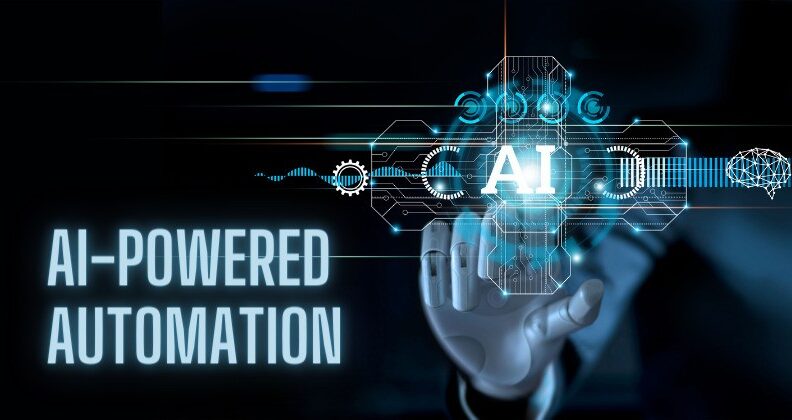AI and Automation: Revolutionizing the Modern Workplace






The integration of automation and AI into the modern workplace marks a pivotal shift in how businesses operate. Technological progress has enabled machines to perform tasks that were once the sole domain of human beings, transforming industries and creating efficiencies previously unimaginable. This evolution is not just changing the landscape of manual work but also reshaping roles that require cognitive skills, thereby revolutionizing the modern workplace.
As automation and AI become more intertwined with everyday business processes, the potential for innovation and productivity increases exponentially. Companies are now able to automate complex tasks, analyze immense datasets with precision, and enhance decision-making processes. The result is a more dynamic, efficient, and competitive marketplace, where technological progress continues to push the boundaries of what is possible.
Understanding the Basics of AI and Automation
At the core of this technological revolution are automation and AI, driving forward the progress that is reshaping industries and work practices. Together, they form the backbone of a new era in business and technology, where the capabilities of machines extend beyond simple tasks to include complex decision-making and problem-solving.
What is Artificial Intelligence (AI)?
Artificial Intelligence, or AI, refers to the simulation of human intelligence in machines. AI enables these machines to perform tasks that typically require human intelligence, such as understanding natural language, recognizing patterns through computer vision, and making decisions. By employing machine learning algorithms, AI can execute complex tasks without needing human intervention, learning from data to improve over time.
Exploring the Realm of Automation
Automation involves the use of technology to execute repetitive tasks with minimal human assistance. It spans a wide range of applications, from simple mechanical processes to complex software that manages data entry and analysis. The goal of automation is to increase efficiency, accuracy, and productivity, reducing the need for human labor in tasks that can be precisely and swiftly handled by machines.
Unveiling the Difference Between AI and Automation
While automation is about setting up systems to perform repetitive tasks like data entry, AI is about setting neural networks and algorithms to mimic human thought processes and decision-making. This fundamental difference highlights how each technology plays a unique role in transforming the workplace.
Similarities and Distinctions
Despite their differences, automation and AI both aim to reduce human labor and streamline business processes. Advances in technology have enabled industries such as manufacturing to automate not just manual tasks but also those that require adaptability and cognitive skills. This synergy of AI and automation is driving unprecedented efficiency and innovation across sectors.
The Synergy of AI in Automation
The convergence of automation and AI represents a powerful synergy that is amplifying the capabilities of both technologies. By integrating AI into automation processes, businesses can achieve a level of efficiency and effectiveness that goes beyond what either technology could accomplish alone. This fusion is paving the way for smarter, more responsive systems that can adapt and learn from their environments.
Enhancing Automation with AI Technologies
The incorporation of AI technologies into automation systems is enhancing the ability of businesses to tackle more complex and nuanced tasks. By leveraging automation and AI, companies can now automate processes that involve decision-making and problem-solving, tasks that were previously thought to require the human touch. This advancement is not just improving operational efficiency but also opening up new possibilities for innovation and service delivery.
Real-World Examples of AI-driven Automation
In customer service, implementing AI through an automation platform has revolutionized how businesses interact with their clients. These AI-driven systems can understand and respond to customer inquiries with high accuracy, providing a seamless service experience. This is just one example of how AI and automation are together enabling digital transformation across various business cases.
AI in Automated Testing: RPA and Beyond
Robotic Process Automation (RPA) is a prime example of AI in automated testing, where it goes beyond simple task automation to include the ability to adapt and improve testing processes based on previous results. This application of AI is transforming the efficiency and reliability of software testing, making it faster and more accurate, thereby reducing the time and cost associated with bringing new software solutions to market.
The Impact of AI and Automation on the Workforce
The collaboration between automation and AI is reshaping the workforce, creating a dynamic where the balance between job loss and creation is constantly evolving. While some roles are becoming obsolete, new opportunities are emerging that require a different set of skills. This transformation is driving a significant shift in labor demand, influencing economies worldwide.
The Future of Jobs: The Balance Between Loss and Creation
Estimates suggest that between 555 million and 890 million new jobs could be created by advances in automation and AI by 2030. However, this technological progress also poses the risk of job displacement, with various sectors facing the challenge of adapting to these changes. The future of jobs will likely see a balance between loss and creation, with the nature of work evolving to meet the demands of a digitally driven economy.
How Jobs Will Transform: Humans and Machines in Collaboration
The integration of AI algorithms and automated systems into the workplace is leading to a shift towards partial automation, where repetitive tasks are handled by machines, allowing human labor to focus on more complex and creative aspects of work. Though automation will displace an estimated 15 percent of the global workforce, or about 400 million workers, it also opens up opportunities for new roles that complement the capabilities of machines.
Skill Shifts: Adapting to the New Work Environment
As the workplace evolves, so does the need for digital skills. The shift towards a more automated and AI-driven environment requires workers to adapt, acquiring new capabilities that enable them to work alongside advanced technologies. This skill shift is not only about mastering new tools but also about developing a mindset that embraces continuous learning and innovation.
Opportunities and Challenges in AI and Automation
The advancement of automation and AI presents a dual-edged sword, offering significant opportunities for economic growth and business transformation, while also posing challenges that need careful navigation. These technologies promise to drive efficiency, enhance productivity, and create new jobs, but they also require societies to address issues related to employment, privacy, and ethics, ensuring that the benefits of these technological innovations are widely distributed and accessible to all.
Economic Growth and Business Transformation Opportunities
Artificial Intelligence (AI) and automation present unprecedented opportunities for economic growth and business transformation. By leveraging neural networks, businesses can analyze vast amounts of data to identify trends, predict customer behavior, and automate decision-making processes. This not only enhances efficiency but also fosters innovation, enabling companies to create new products and services. Moreover, the adoption of AI and automation technologies drives cost savings, boosts productivity, and enhances competitiveness, positioning businesses for long-term success in the evolving digital landscape.
Addressing Societal Challenges Through Innovation
Innovation through AI and automation extends beyond economic benefits, offering solutions to pressing societal challenges. By automating routine tasks, these technologies free up human intellect for creative and strategic endeavors, potentially reducing unemployment in the long term.
Navigating the Challenges: Ethics, Privacy, and Employment
The integration of AI and automation into workplaces echoes the workforce transitions of the 19th century’s Industrial Revolution, presenting similar ethical, privacy, and employment challenges. Ensuring the ethical use of AI, safeguarding privacy, and managing workforce transitions require thoughtful strategies. Learning from the past, it’s imperative to navigate these challenges by fostering an environment where innovation is balanced with the welfare of society, ensuring that the benefits of AI and automation are distributed equitably across all sectors.
Preparing for a Future with AI and Automation
As the future tilts increasingly towards AI and automation, businesses and individuals must prepare for the ensuing changes. This preparation involves understanding the potential of these technologies to transform industries, redefine job roles, and create new opportunities. Embracing digital transformation, continuously learning new skills, and adapting to evolving work environments will be crucial for success. Businesses, in particular, must stay abreast of technological advancements to leverage AI and automation for improved efficiency, innovation, and competitiveness.
Identifying Business Needs for AI-based Automation
Before implementing AI, businesses must thoroughly analyze their operations to identify areas where AI-based automation can deliver the most value. This involves determining business cases where AI can enhance efficiency, reduce costs, or solve complex problems. Successful digital transformation hinges on aligning AI initiatives with strategic business goals, ensuring that the adoption of AI and automation technologies directly contributes to achieving business objectives.
Selecting the Right Tools and Technologies for Implementation
Choosing the right tools and technologies is crucial for the successful implementation of AI and automation. Organizations must consider the specific challenges they face, the quality of their training data, and the AI techniques that best address their needs.
The Importance of Continuous Learning and Adaptation
The rapid pace of technological advancement in AI and automation necessitates continuous learning and adaptation. Organizations and their employees must commit to lifelong learning, staying updated on the latest technologies and methodologies. This adaptability not only ensures relevance in an ever-changing landscape but also enables businesses and individuals to harness the full potential of AI and automation for innovation and growth.
The Role of AI and Automation in the Economy and Society
AI and automation are transforming the economy and society, driving progress in ways that were unimaginable a few decades ago. From optimizing supply chains to enhancing customer experiences, these technologies are revolutionizing industries. Their role extends beyond economic impact, influencing societal norms and expectations, and offering new solutions to age-old problems.
Accelerating Progress and Its Potential for Good
AI and automation have the potential to accelerate progress in numerous fields, including healthcare, education, and environmental protection. For instance, AI-driven systems in grocery stores can optimize inventory management, reducing waste and ensuring fresher produce for consumers. Such advancements not only improve efficiency and sustainability but also have the potential to greatly enhance the quality of life.
Tackling Moonshot Societal Challenges with Advanced Technologies
Advanced technologies like AI and automation are pivotal in addressing moonshot challenges, from climate change to global health crises.
Facing Workforce Challenges in Advanced Economies
The workforce transitions prompted by AI and automation today mirror the upheavals of the 19th century’s Industrial Revolution, challenging advanced economies to rethink education and training systems. Adapting to these changes requires a focus on reskilling and upskilling, ensuring that workers can thrive in a future where human-machine collaboration is the norm.
Implementing AI and Automation in Your Business
Implementing AI and automation requires a strategic approach, beginning with a clear understanding of the business processes that stand to benefit most from technological integration. This entails evaluating existing workflows, identifying inefficiencies, and pinpointing opportunities for automation to enhance productivity and innovation.
Steps to Get Started with AI-based Automation
To embark on AI-based automation, businesses should start with a comprehensive assessment of their needs, followed by identifying the AI solutions that best meet these requirements. This process involves researching available technologies, considering potential ROI, and planning for seamless integration with existing systems.
Researching and Selecting Technologies
Effective implementation begins with thorough research and selection of the appropriate technologies. Companies face challenges in choosing solutions that align with their objectives, necessitating a deep understanding of the available AI techniques and the quality of their training data.
Implementing and Integrating AI Solutions
Successfully implementing and integrating AI solutions into business processes demands careful planning, skilled resources, and ongoing support. It involves not only the technical aspects of adding AI to existing systems but also managing the change within the organization, ensuring that employees are trained and workflows are adapted to maximize the benefits of AI and automation.
How AI and Automation Are Shaping the Future of Work
Transforming Workplaces and Workflows
AI and automation technologies are fundamentally changing how workplaces operate and how workflows are designed. By integrating humans and machines, businesses are achieving unprecedented levels of efficiency and productivity. This synergy allows machines to handle repetitive tasks, while humans focus on complex decision-making and creativity. The result is a more dynamic, innovative, and productive workplace, where the strengths of both humans and machines are leveraged to achieve better outcomes.
The Skill Shift and Future Workforce Dynamics
The rise of AI and automation is causing a significant shift in the labor market, demanding a higher prevalence of digital skills and software development capabilities. As routine tasks are automated, the workforce is pushed towards roles that require advanced technical skills, critical thinking, and creativity. This evolution is reshaping the future of work and necessitating a reevaluation of educational systems to prepare the next generation for the challenges ahead.
Pressure on Wages and the Economic Implications
The integration of AI and automation into various sectors is exerting pressure on wages and stirring economic implications. As automation streamlines processes and reduces the need for manual tasks, the demand for lower-skilled jobs decreases, potentially leading to wage stagnation in these sectors. However, in industries where AI and automation enhance human capabilities, there may be opportunities for wage growth, highlighting the complex relationship between technology, labor demand, and economic dynamics.
Concluding Thoughts on AI and Automation
The journey of AI adoption and the expansion of industrial automation are indicative of exponential growth in technology capabilities, aiming to mimic humans with intelligent automation. From autonomous vehicles revolutionizing transport to AI in automation enhancing business process management, AI-powered automation is setting new standards. However, the transition demands robust safety nets and strategic planning to mitigate workforce displacement and ensure equitable benefits across society. Embracing AI technology holds the potential to transform industries and societal structures, making it imperative to navigate the challenges with thoughtful policies and inclusive strategies.
Embracing the Future: Opportunities for Businesses and Individuals
Businesses and individuals stand on the brink of a transformative era with AI and automation. The shift towards intelligent automation and automated customer interactions opens vast opportunities for efficiency gains and innovative service offerings. For individuals, acquiring skills in AI technology and understanding the dynamics of AI-powered automation can unlock new career pathways and personal growth opportunities. Embracing these changes with a mindset geared towards continuous learning and adaptation will be key to thriving in the evolving landscape.
Overcoming the Challenges: Strategies for Success
To successfully navigate the transition towards more automated and AI-driven workflows, strategies focused on workforce transitions, productivity and efficiency, and educational requirements are essential. Partnering alongside machines requires a workforce skilled in automation tools and data security, emphasizing the importance of speed and accuracy in operations. Automation streamlines processes, but it also necessitates a shift in how manual tasks are valued and integrated. By addressing these challenges head-on, businesses and individuals can leverage the benefits of AI and automation, ensuring a resilient and prosperous future.